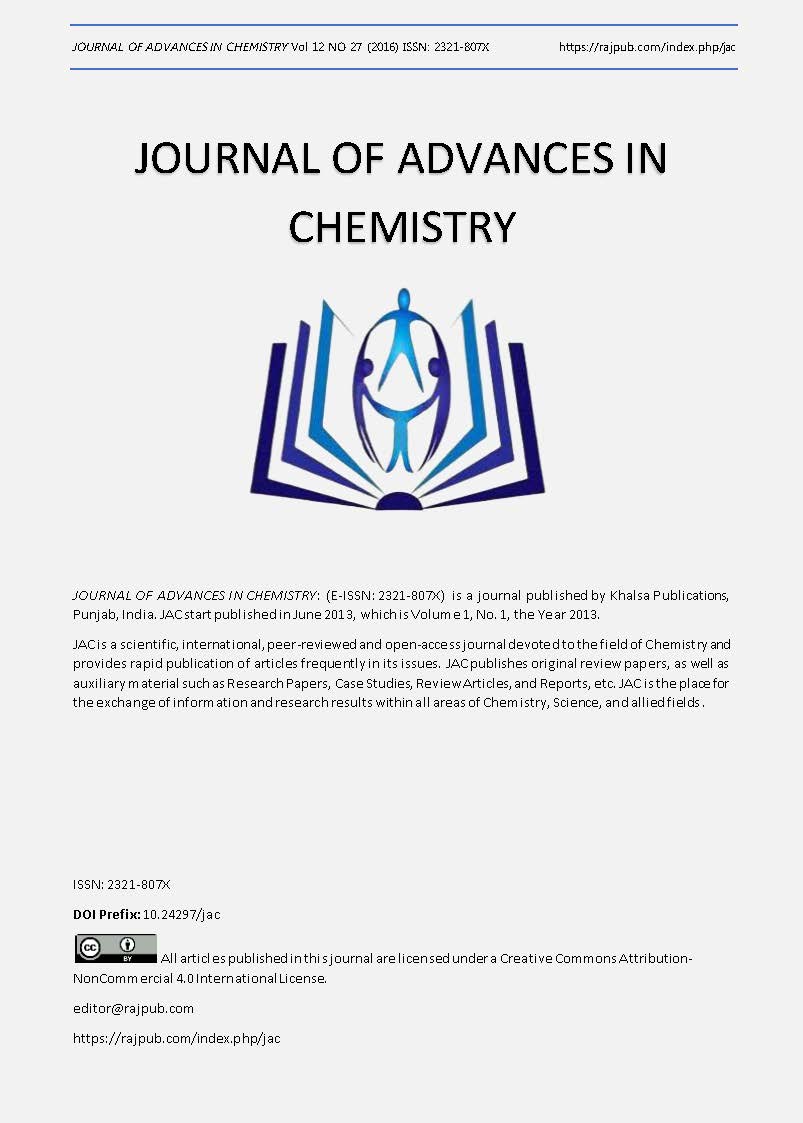Terminalia catappa fruit pigments for dye sensitized solar cell applications
DOI:
https://doi.org/10.24297/jac.v12i27.6709Keywords:
Dye sensitized solar cells, Natural dyes, ZnO nanoparticlesAbstract
The dye sensitized solar cells have been assembled by using natural dye extracted from Terminalia catappa fruits. The photoelectrode for dye sensitized solar cell were prepared using green synthesized ZnO nanoparticles using doctor blade technique. The photoelectrode were sensitized using the extracted dyes. The fabricated solar cell exhibited short circuit current density of 4.9 mA and open circuit voltage of 0.472 V. The efficiency of the cell was found to be 1.58%. The photovoltaic performance of the constructed solar cell show good conversion efficiency. This indicates that Terminalia catappa fruit extracts can be used as an effective sensitizer.
Downloads
References
2. Vidor, Fábio F., et al. "ZnO nanoparticle thin-film transistors on flexible substrate using spray-coating technique." Microelectronic Engineering 159 (2016): 155-158.
3. Wahab, Rizwan, et al. "Utilization of photocatalytic ZnO nanoparticles for deactivation of safranine dye and their applications for statistical analysis."Physica E: Low-dimensional Systems and Nanostructures 69 (2015): 101-108.
4. Lima, F. Anderson S., Igor F. Vasconcelos, and Monica Lira-Cantú. "Electrochemically synthesized mesoporous thin films of ZnO for highly efficient dye sensitized solar cells." Ceramics International 41.8 (2015): 9314-9320.
5. Mathew, Simon, et al. "Dye-sensitized solar cells with 13% efficiency achieved through the molecular engineering of porphyrin sensitizers." Nature chemistry 6.3 (2014): 242-247.
6. Giribabu, Lingamallu, and Ravi Kumar Kanaparthi. "Are porphyrins an alternative to ruthenium (II) sensitizers for dye-sensitized solar cells?."Current Science(Bangalore) 104.7 (2013): 847-855.
7. Yuan, Liu, et al. "Acceptor Endâ€Capped Oligomeric Conjugated Molecules with Broadened Absorption and Enhanced Extinction Coefficients for Highâ€Efficiency Organic Solar Cells." Advanced Materials (2016).
8. Liu, Shenghua, et al. "Au/Ag core–shell nanocuboids for high-efficiency organic solar cells with broadband plasmonic enhancement." Energy & Environmental Science 9.3 (2016): 898-905.
9. Bella, Federico, Jijeesh R. Nair, and Claudio Gerbaldi . "Towards green, efficient and durable quasi -solid dyesensitized solar cells integrated with a cellulose-based gel-polymer electrolyte optimized by a chemometric DoE approach." RSC Advances 3.36 (2013): 15993-16001.
10. Chiappone, Annalisa, et al. "Structure–Performance Correlation of Nanocelluloseâ€Based Polymer Electrolytes for Efficient Quasiâ€solid DSSCs."ChemElectroChem 1.8 (2014): 1350-1358.
11. El-Ghamri, Hatem S., et al. "Dye-sensitized solar cells with natural dyes extracted from plant seeds." Materials Science-Poland 32.4 (2014): 547-554.
12. Kumar, P. Naresh, and K. Sakthivel. "PREPARATION AND CHARACTERIZATION OF LOW COST PRUSSIAN BLUE SENSITIZED SOLAR CELL." Journal of Ovonic Research Vol 11.4 (2015): 169-173.
13. Shanmugam, Vinoth, et al. "Performance of dye-sensitized solar cells fabricated with extracts from fruits of ivy gourd and flowers of red frangipani as sensitizers." Spectrochimica Acta Part A: Molecular and Biomolecular Spectroscopy 104 (2013): 35-40.
14. Hammad, Talaat M., Jamil K. Salem, and R. G. Harrison. "Structure, optical properties and synthesis of Codoped ZnO superstructures." Applied Nanoscience 3.2 (2013): 133-139.
15. Dikshit, Madhurima, and Rupali Krishna Samudrasok. "Nutritional evaluation of outer fleshy coat of Termi nalia catappa fruit in two varieties." International journal of food sciences and nutrition 62.1 (2011): 47-51.
Downloads
Published
How to Cite
Issue
Section
License
 All articles published in Journal of Advances in Linguistics are licensed under a Creative Commons Attribution 4.0 International License.
All articles published in Journal of Advances in Linguistics are licensed under a Creative Commons Attribution 4.0 International License.




